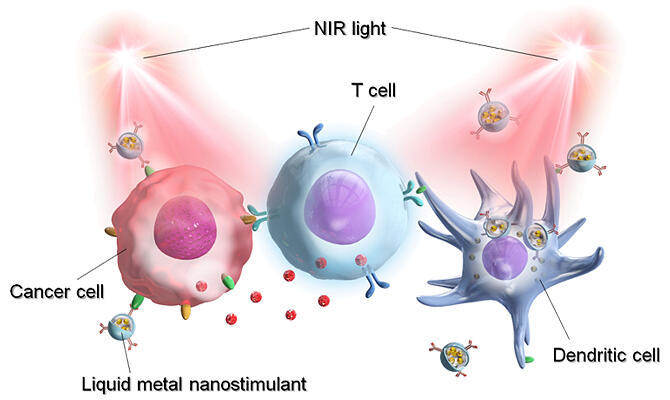A research group led by Associate Professor Eijiro Miyako (Materials Chemistry Frontier Research Area of the Graduate School of Advanced Science and Technology, Japan Advanced Institute of Science and Technology (JAIST)) has announced the successful development of a cancer immunotherapy based on liquid metal (LM) nanoparticles. Nanoparticles with various immunostimulants adsorbed onto the LM gallium-indium (Ga/In) alloys were prepared, and their high stability and ability to permeate the cell membrane as well as low cytotoxicity were confirmed. Their uptake into cancer tissues and therapeutic effects were confirmed via mice experiments. This achievement is expected to trigger the development of new cancer diagnostic and treatment technologies, and the results were published in the July 28 issue of the international journal Advanced Functional Materials.

Provided by Eijiro Miyako from JAIST
Ga/In-based LM alloys possess high biocompatibility and excellent physicochemical properties at room temperature. Therefore, research involving their application in the biomedical field has been gaining increasing traction.
The research group has initiated studies on cancer diagnosis and treatment by selectively delivering LM nanoparticle-bound immunostimulatory substances to cancerous tissues. This approach holds the potential to not only induce strong antitumor effects through the immune system, but also to visualize the affected areas for photothermal conversion therapy using highly biocompatible near-infrared light.
To deliver the effector molecules to the cancerous areas and activate immune cells, the research group prepared nanoparticles with the following drugs and compounds adsorbed onto the LM alloy surface: (a) anti-programmed death ligand-1 antibody (anti-PD-L1), an immune checkpoint inhibitor which inhibits the interaction between PD-1 on T cells and PD-L1 expressed by cancer cells and antigen-presenting cells, thereby inducing antitumor effects; (b) imiquimod, the immunomodulator which activates dendritic cells and treats early basal cell skin cancer and specific skin disorders; (c) indocyanine green, the fluorescent agent which emits near-infrared fluorescence when exposed to near-infrared light (commonly used in liver function tests); and (d) polyethylene glycol-lipid complex, which is used as a drug delivery system to solubilize lipophilic drugs.
The size of the prepared LM nanoparticles remained stable for more than 10 days, and the particles easily permeated the cell membrane. After confirming that the nanoparticles are non-toxic and that they generate heat when irradiated with near-infrared light, their abilities to target (and hence reveal) and treat cancerous tissue were investigated.
LM nanoparticles were administered to mice one week after the transplantation of colorectal cancer cells into the animals. After 24 hours, the mice were exposed to a near-infrared light at 740-790 nm. Consequently, images showing only the fluorescence-emitting cancerous area were captured. This indicated that the nanoparticles were taken up by the cancer tissue through the enhanced permeability and retention (EPR) effect. By the EPR effect, nanoparticles less than 100 nm in size accumulate specifically in tumor tissues after entering them through tumor blood vessels, without leaking into normal cells.
When the area where these nanoparticles had accumulated was irradiated with a near-infrared light at 808 nm, the combination of immune-activating and photothermal conversion effects led to the successful eradication of cancer within 14 days. Further evaluation of the biocompatibility and cytotoxicity of the LM nanoparticles revealed that they had a minor effect on the living body and were not cytotoxic.
The developed LM nanoparticles are expected to not only demonstrate their potential for cancer diagnosis and immunotherapy, but also contribute (as a technological basis) toward the design of materials that are useful in diverse fields, such as nanotechnology, optics and immunology.
Miyako stated, "Although cancer photoimmunotherapy is already in the practical-application stage, it is not applicable for all cancer types. By utilizing LM nanoparticles, I expect that affordable and safe cancer treatments can be attained. Additionally, with this technology, I hope that cost-effective and straightforward cancer diagnosis becomes possible."
Journal Information
Publication: Advanced Functional Materials
Title: Light-Activatable Liquid Metal Immunostimulants for Cancer Nanotheranostics
DOI: 10.1002/adfm.202305886
This article has been translated by JST with permission from The Science News Ltd. (https://sci-news.co.jp/). Unauthorized reproduction of the article and photographs is prohibited.




